
Keke Kaikhosroshvili
Keke is Zavvy's expert in learning experience. On our blog, she shares experience and insights based on her studies in learning design and experiences made with our customers.

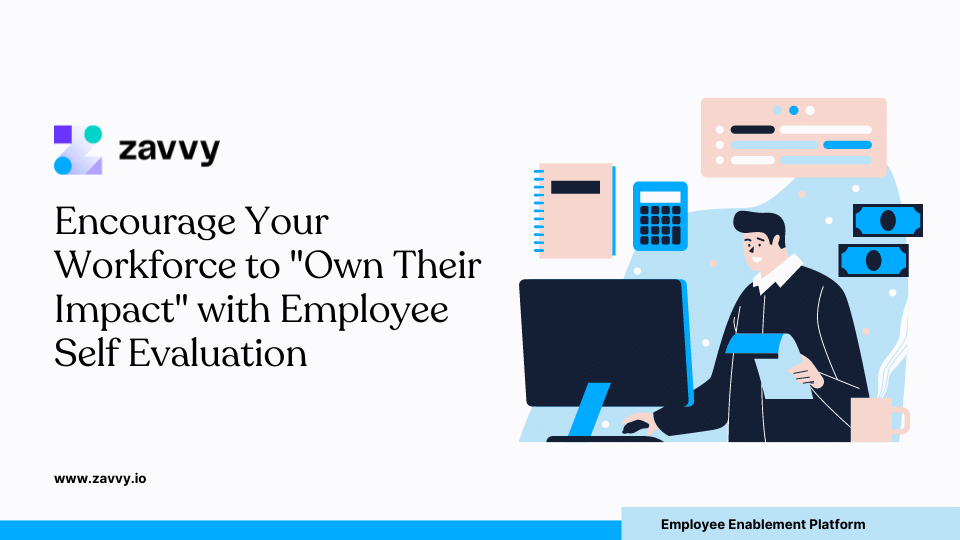
A worrying workplace trend has emerged: employees don't think their employers are listening to them. 83% of employees don't believe they're "fairly or equally" heard, according to research by the Workforce Institute.
But feeling heard and valued is an essential development component, allowing employees to speak up, raise concerns, admit challenges, and request resources to progress.
Employers with selective hearing aren't helping their workforce thrive. Plus, it negatively affects productivity and takes a chunk off the bottom line!
So, what's the answer?
Let's look at the impact of employee self evaluation and the magic that happens when employers invite employees to "own their impact" through a self-review.
Together with our curators, we have created a library of actionable digital marketing resources. Personalized to your team's needs.
An employee self evaluation (also known as an employee self assessment) forms part of a 360 feedback cycle. This style of review process gathers feedback from multiple sources to provide a broad overview of how the employee is performing.
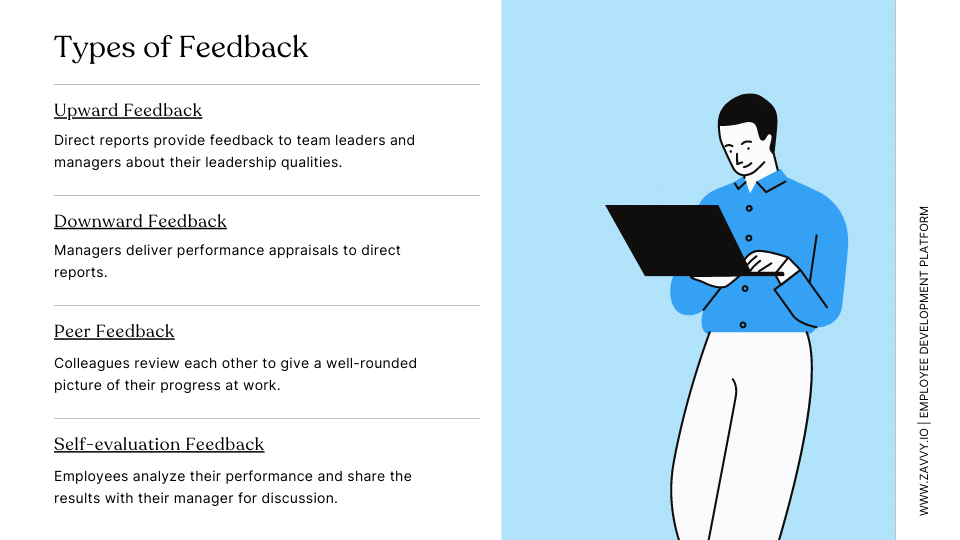
⬆️ Upward feedback: Direct reports provide feedback to their team leaders and managers about their leadership qualities and company communication.
⬇️ Downward feedback: Managers deliver performance appraisals to direct reports, as in a traditional annual feedback review.
👥 Peer feedback: Colleagues review each other to give a well-rounded picture of their progress at work.
🔂 Self evaluation: Employees analyze their performance and share the results with their manager for discussion.
"Self evaluation is a great way to find out what employees think about themselves and their impact on the organization. If you're an HR leader running self evaluation sessions for employees, you should listen carefully to what they have to say about their feelings or qualities.
You can later use it to their advantage by cheering them up or advising what they should focus on the most. Remember that it's their time to explore their own thoughts and feelings, and you're there only to listen and help them improve their performance." - Monika Dmochowska, Talent Acquisition Specialist at Tidio.
Self evaluation differs from self reflection, although the two can and should coexist.
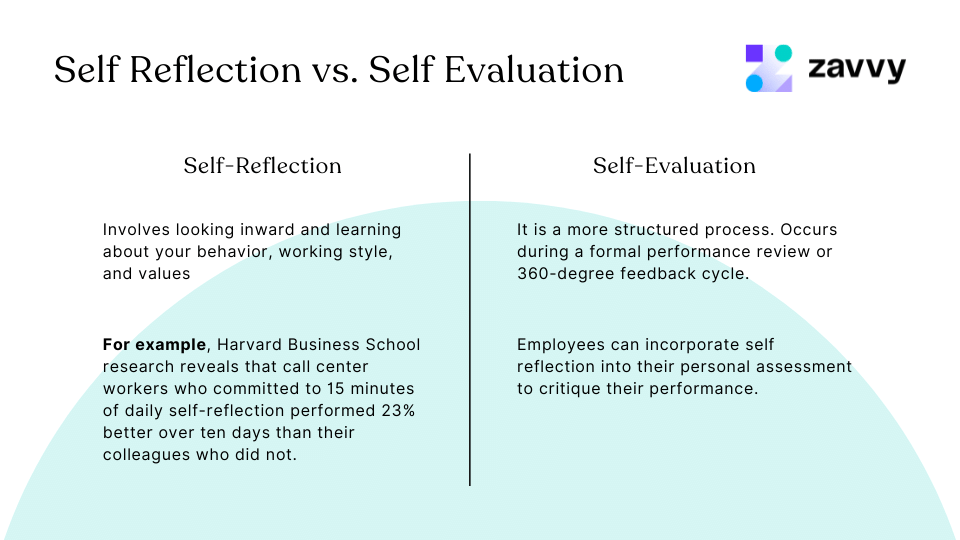
For example, Harvard Business School research reveals that call center workers who committed to 15 minutes of daily self-reflection performed 23% better over ten days than their colleagues who did not.
Self evaluation sounds like a solo activity, but it also positively influences managers and the entire organization.
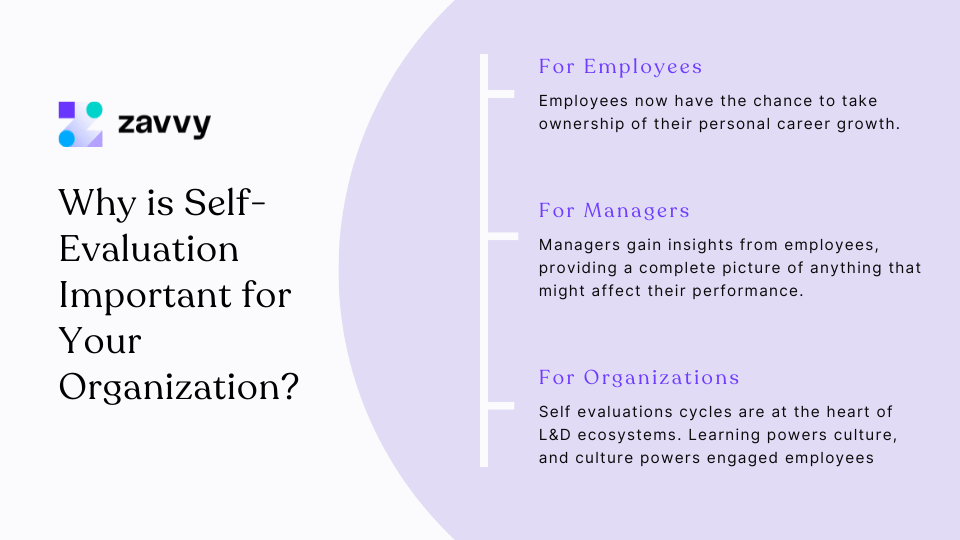
Companies often overlook employees' opinions in the architecture of traditional performance reviews. But self evaluation as part of a 360 feedback model means that employees now have a voice and the chance to take ownership of their personal career growth.
Using the Zavvy 360 feedback model, employees can influence their career paths rather than waiting for team leaders or managers to assign goals that are specific to their job description but that don't appeal to them.
The result?
Employees who feel heard are more invested in setting their goals rather than feeling like they're the target of an archaic performance system.
Managers who incorporate self evaluation into performance cycles gain feedback straight from the horse's mouth, providing a complete picture of anything that might affect employee performance.
Asking employees to participate in their review cycles doesn't just have positive motives. It also boosts morale.
94.7% of highly engaged people feel their employer takes their feedback seriously and wants to understand the direct links between their evaluation and their work.
Arthur Worsley, the founder of The Art of Living, a website that helps top performers lead happier, more balanced lives, agrees with the importance of self evaluations and stresses how they can help managers to retain their most talented team members:
"Self evaluations are integral to employee feedback cycles in our company because they help us to understand where we're doing well and where we need improvement, according to our employees.
These evaluations are also a great way to determine which essential areas each employee needs further support. The more effective our support provision, the more likely that our employees' performance will improve and the more likely we'll be able to retain them for the long term."
A company with an established culture of learning will better engage its employees.
As the LinkedIn Workplace Learning report puts it:
"Learning powers culture, and culture powers engaged employees who are energized to innovate, delight customers, and beat the competition."
Self evaluations as part of 360 feedback cycles are at the heart of this L&D ecosystem.
Organizations such as Adobe and Netflix are already committed to this way of working. But it's not just the tech giants that are on board. L&D teams in all kinds of businesses reap the benefits of a system that starts and ends with the employee.
Although employee growth plans are individually tailored, they benefit the entire organization by accelerating internal career moves.
54% of L&D pros agree that internal mobility is a higher priority than before the pandemic began in 2020, shows the same LinkedIn report.
Hurrah, you've decided to implement employee self evaluation questions into your feedback and growth cycles.
But how do you know what to ask?
Just because this part of the wheel is employee-centric, it doesn't mean it should be an unstructured hands-off activity.
Here are some tips for creating the best self evaluation questions. You and your employees will thank us.
The SMART system will help you craft helpful questions and is also a valuable way for employees to set future goals for themselves.
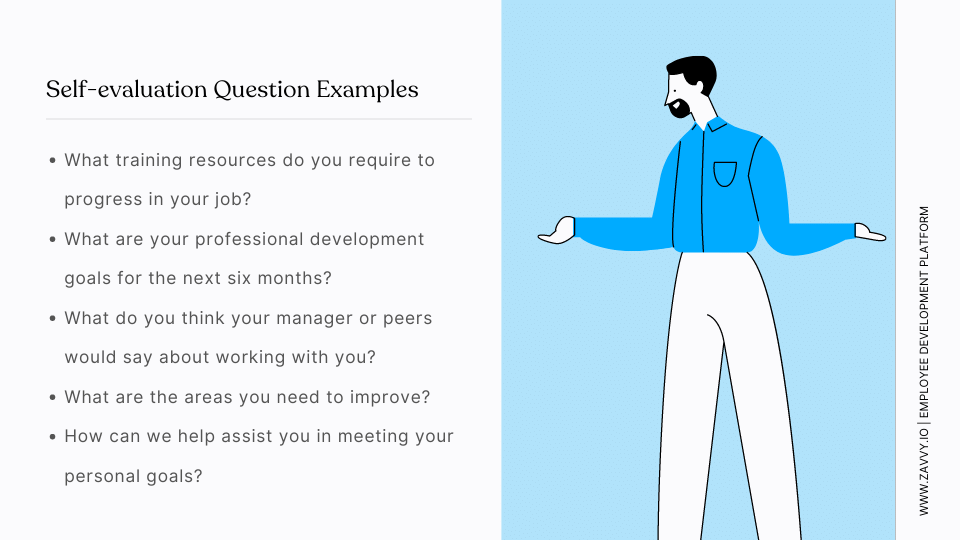
Avoid using closed-ended questions that prompt a Yes or No response without further elaboration. Instead, choose open-ended questions that allow an employee to expand their thoughts. Here are some examples of questions you might use:
If you want your employees to invest in the process thoroughly, there are some tips for setting up the self evaluation system and guiding individuals to participate.
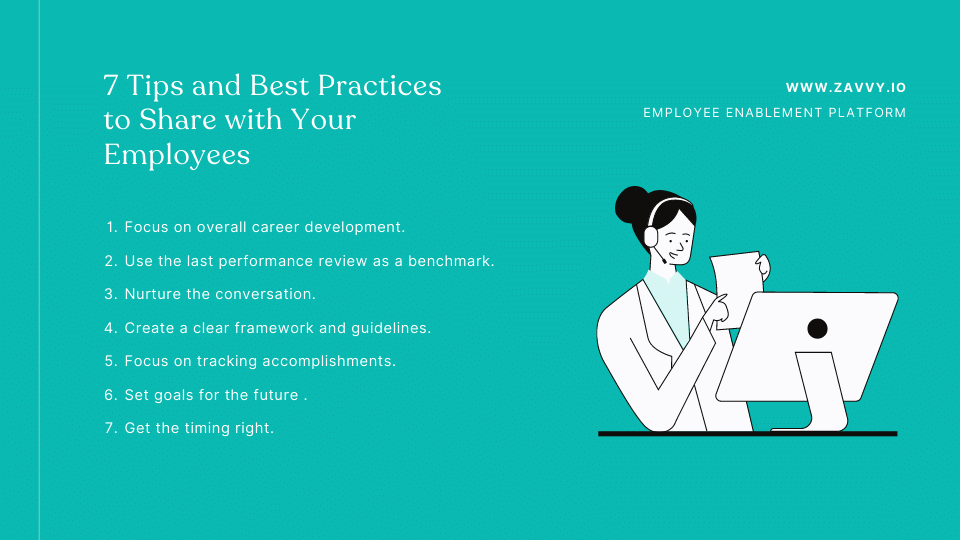
Remember: if retention and productivity are two of your main drivers, you should focus on asking questions about the employee's overall career journey rather than reflecting too heavily on their current role.
Even if your employees are not over the moon about their job, you can still retain them by offering room to grow.
Tip: Encourage them to set career development paths that explore other areas of your company. These may include promotions, lateral moves, and secondments.
When looking at career development, it's helpful to go back and revisit the last performance review.
What goals did they set?
What feedback did they receive?
What progress have they made?
Tip: Use all information you have to set the stage for future conversations and ensure everyone is on the same page.
Strike the perfect balance between asking thought-provoking questions without being overwhelming.
Tip: No one wants to spend hours filling out endless pages of self evaluation questions, so make it clear that the process forms the foundation of a conversation that will continue off-page with a manager.
An open dialogue will ensure the review process is as helpful and meaningful as possible.
If you want to collect comparable quality data that can produce actionable insights, it's essential to have a clear framework and guidelines in place.
Show your employees exactly how the evaluation process works and provide example answers for inspiration.
Tip: You can even highlight successful employees who have chosen an exciting career development path and have moved around internally thanks to their self evaluation.
Be data-driven in your approach to tracking accomplishments. This helps identify opportunities for improvement and makes it easier to navigate awkward conversations where employees and managers might disagree on whether they have reached a milestone.
Create a culture where it's acceptable and even invited to acknowledge mistakes, own them, and move on. Employees can use this experience to set new goals using the SMART acronym outlined above.
Identify the right time to send out your self evaluation form before a job performance review. You want to give the employee enough time to reflect, but not so much time that their input becomes outdated before their review meeting.
Logan Mallory, VP of employee engagement platform Motivosity explains:
"Self evaluations are a very important part of our 360 degree feedback process. We conduct them using surveys sent out a week prior to employees' meetings with their managers. We consider them equally with peer reviews, as self-awareness is one of the skills we help our employees develop and improve upon."
Zavvy's mission is to support companies in building actionable feedback cycles that managers and employees find rewarding and worth investing their time in.
Along with our 360 feedback software, we've also put together this employee self evaluation template.
Our recommendation: use this template as a base and customize it to fit your organization and specific roles.
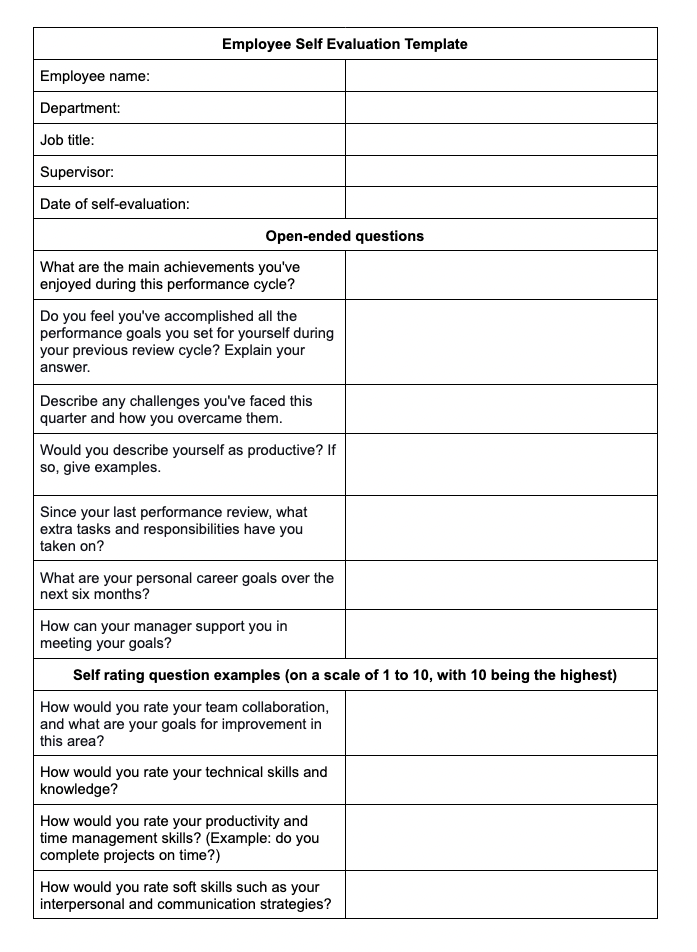
Deciding to commit to employee appraisals as part of performance evaluations is only the first step.
The next is committing to a feedback system with a clear purpose that drives meaningful personal growth. Without this, companies can suffer from a lack of clarity, and feedback bias can also creep into your L&D culture.
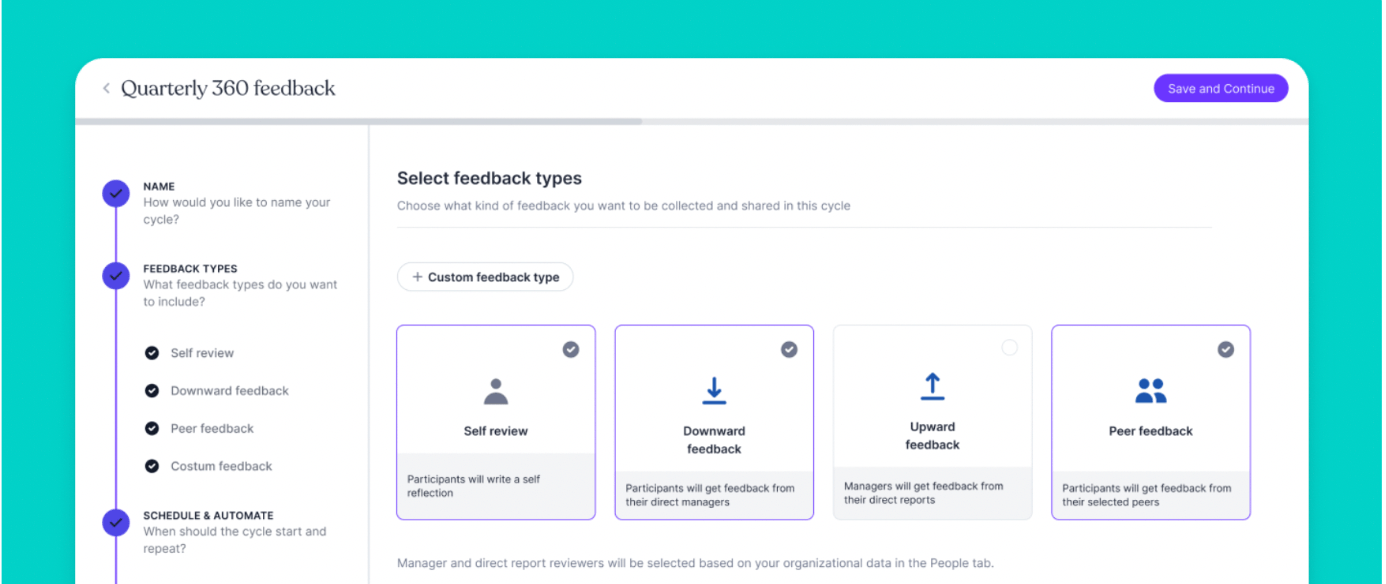
Zavvy's 360 review tool makes it easy for human resources teams to launch and maintain a feedback ecosystem including upward, downward, peer, and self feedback programs. Plus, your colleagues will share reinforcement and redirecting recommendations with each other, so each team member has the opportunity to grow with precision.
See it in action: Book a free 30 minutes demo with our specialists.
Upskill your team every week with the best contents and personalized recommendations.

A worrying workplace trend has emerged: employees don't think their employers are listening to them. 83% of employees don't believe they're "fairly or equally" heard, according to research by the Workforce Institute.
But feeling heard and valued is an essential development component, allowing employees to speak up, raise concerns, admit challenges, and request resources to progress.
Employers with selective hearing aren't helping their workforce thrive. Plus, it negatively affects productivity and takes a chunk off the bottom line!
So, what's the answer?
Let's look at the impact of employee self evaluation and the magic that happens when employers invite employees to "own their impact" through a self-review.
Get a demo!
We'll be happy to show you around and answer all your questions.
Trusted by innovative companies



We'll be happy to show you around, answer your questions, or arrange a free trial.
Erhalten Sie eine kostenlose Demo unserer Onboarding-Software.
Vertraut von



Your Training & Development Strategy - Solved in 1 Tool.
Trusted by innovative companies



We'll be happy to show you around, answer your questions, or arrange a free trial.
Learn how Zavvy helps you drive performance, development, and engagement.
Trusted by innovative companies



We'll be happy to show you around, answer your questions, or arrange a free trial.
We'll be happy to show you around and answer all your questions.
Trusted by innovative companies



We'll be happy to show you around, answer your questions, or arrange a free trial.
Gerne zeigen wir Ihnen ganz unverbindlich unsere Plattform im Detail.
Vertraut von modernen Unternehmen



Get a demo!
We'll be happy to show you around and answer all your questions.
Trusted by innovative companies



We'll be happy to show you around, answer your questions, or arrange a free trial.
Erhalten Sie eine kostenlose Demo unserer Software für Mitarbeiterenwicklung und Training.
Moderne Unternehmen
setzen auf Zavvy


